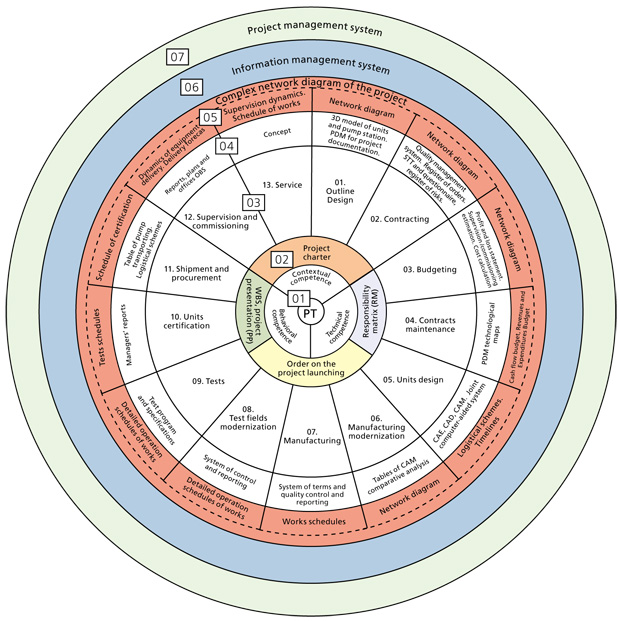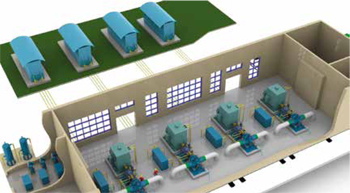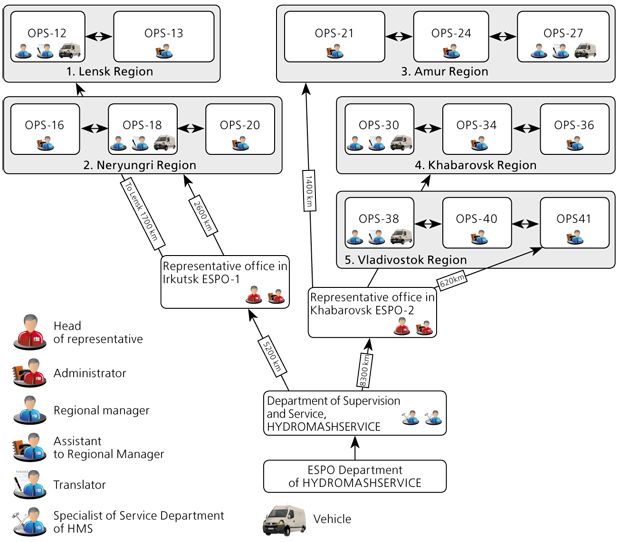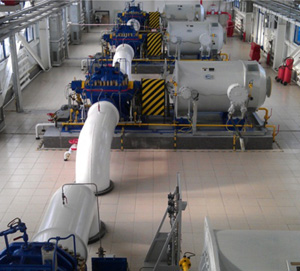|
01.12.2012
Integrated Complex Projects Management Practice of HMS Group
Both in Kazakhstan’s oil and gas sector as well as that of the Russian Federation, there is an increasing demand for highquality services in implementing complex projects for development and delivery of sophisticated technological systems and turnkey facilities construction (EPC1). While implementing large multilevel projects, oil and gas companies are actively working at costs optimization and selection of the most efficient design and state-of-the-art technical solutions. The main problems oil and gas companies face while implementing large complex projects are insufficient operational experience of local contractors in the format of EPC-projects which lead to lengthy terms and a low quality of development of design solutions, impossibility to provide manufacture of state-of-the-art equipment, as well as improper implementation practice and delay in construction terms. HMS Group, a large machinebuilding and engineering holding, is one of the first Russian companies to actively develop the business function of implementing complex projects on a turnkey basis. The Group’s main competitive advantages in implementation of EPCprojects are strong scientific and production base, competence in developing projects management system and a dedicated team of professionals. Successful experience in implementing some complex projects has allowed HMS Group to form an efficient instrument in designing and construction of infrastructure of oil and gas and gas-condensate fields, oil and gas processing and transportation facilities, trunk and field pipelines, as well as the delivery of sophisticated technological equipment. The major engineering projects implemented by HMS Group in two recent years are the projects for design development, production, testing, procurement and installation of over 50 unique trunk pump units for pipeline systems of ESPO and Purpe-Samotlor. The following design, production and engineering assets of HMS Group have been involved in the projects: managing company HMS Group and HYDROMASHSERVICE (the Group’s associated trading and engineering company). During the implementation of ESPO and Purpe-Samotlor projects, the ample opportunities of HMS Group’s assets were united by the integrated corporate project management system (CPMS, Fig. 1), including all instruments needed for successful implementation of sophisticated EPC-projects in oil and gas industry.
Fig. 1. Corporate project management system 01. Circle of the project team: 55 elements of competence
In project management, HMS Group uses a matrix scheme with a strong matrix: in the beginning of implementation of the project interfunctional team of specialists is formed who later solve the tasks together with the heads of functional divisions. The project team includes specialists of the managing company, design institute, basic production enterprise and operational company. The project’s team is formed in such a way that professional skills of its members and their key characteristics comply with national requirements to the competence of specialists (circle 01 CPMS). The project team works out and submits to the interested specialists and top management of the operating company (including the curator2 and the project’s customer) and the enterprises participating in the project, the project’s presentation, work breakdown structure, matrix of responsibility and project charter (a basic package of the project instruments, circle 02 CPMS). The project’s presentation is followed by coordination and approval of these instruments. The project head, together with the team develop work breakdown structure (WBS, circle 03 CPMS), including the main package of works decomposed up to final tasks. On the basis of WBS the network schedule of the project and other instruments of timeline management system are built: production, delivery, installation and commissioning schedules. These schedules are promptly approved by the curator, the project’s customer, and heads of design institute and production enterprise and are entered into the Product Data Management/PDM-system to enable the project team to work with them cooperatively.
The PDM-system operates as a core of the project information management system (circle 06 CPMS) and makes it possible for the project team to jointly work with design information remotely (if necessary, through a web interface), while information security is provided. The project information management system and systematized storage of documents it contains, makes it possible for project team specialists to find any document of the project among thousands of documents in less than three minutes. The speed of access to the information is a critical success factor as far as official correspondence, negotiations and drafting contracts are concerned. Besides electronic documents the PDM-system contains 3D models and assembly units of delivered equipment applied at all stages of the project (Fig. 2). These models form the information bank of technical solutions of key suppliers of equipment for oil and gas industry. The information bank makes it possible, for example, to present to the final customer a complex threedimensional visualization of the facility being under construction which is elaborated with the use of three-dimensional models of suppliers of all types of equipment. Given the operation of two other main components of CPMS – timeline management system and the project budget – the model of the delivered facility becomes five-dimensional: each detail of equipment, besides its geometrical characteristics, acquires temporary (terms of production and delivery) and value characteristics (selling price). As a result of a well-coordinated work of PDM-system project team specialists, the project curator and the final customer for whom this is often crucial can get a complex assessment of the project performance. The network of regional representatives of the associated trading and engineering company of HMS Group – HYDROMASHSERVICE is important for running major remote projects and achieving the project’s successful results. For example, to implement an ESPO project the teams of regional managers working along 5000 kilometers of the pipeline system were formed (Fig. 3). Owing to such approach, given a well-coordinated work of Moscow office and regional representatives with the use of the set of specially elaborated rules regulating the project management, the questions of the customer were successfully solved 24 hours a day 7 days a week.
Fig. 3. Organizational chart of HYDROMASHSERVICE offices at ESPO facilities The described elements of the projects corporate management system, applied by all the specialists of the project team, give an essential integrated effect providing success of the project not only for the companies of HMS Group, but also for final customers. Thus, the main advantages for the customers are:
Going back to the issue on the project’s success, the experience of American researchers, Jeffry Pinto and Dennis Slevin3, who worked out the following concept of “success of the project” in four factors is of great importance:
For defining the ways of achieving these four success factors the researchers have polled 50 heads of the projects and studied the management of several projects carried out within two years. As a result, they proposed a system consisting of 10 criteria, which they called “the project’s critical success factors”.3 Corporate project management system operating in the companies of HMS Group envisages the work of a project team, including among others, these critical factors.
As an accomplishment confirming efficiency of the corporate project management system of HMS Group, we will summarize the results of implementation of the projects for development and delivery of unique trunk pump units for Purpe-Samotlor pipeline system: 1. The project has been completed within contract terms.
4. Results of the project: trunk pump units of oil pumping stations efficiently operate under oil transportation via Purpe-Samotlor pipeline system (Fig. 4). Based on obtained experience, as a result of implementation of the above-described projects for Purpe- Samotlor and ESPO, and also other complex projects of HMS Group implemented on a turnkey basis, the Group’s specialists have formed a corporate bank of knowledge with the ordered structure of information sources, regulations and methods widely applied in new EPC-projects management. Y.A. Osipenko, Deputy CEO, Certified Project Manager, HYDROMASHSERVICE (HMS Group);
¹ EPC (Engineering, Procurement, Construction).
² Curator of the project - the employee (as a rule, a top manager) of the organization implementing the project. He supervises over the project on behalf of the organization, provides general control and project support (financial, material, human and other resources). ³ Jeffrey K. Pinto, Dennis P. Slevin. Critical Success Factors in Effective Project Implementation http://www.europm.com/csf.html |
USEFUL LINKS
|
- ProjectsSupporting materials
- | About us
- | Products
- | Services
- | Press-centre
- | Projects
- | Supporting materials
- | Contacts
- | Site map
125252, Moscow, 12 Aviakonstructor Mikoyan street
Phone: +7 (495) 664-81-71, fax: +7 (495) 664-81-72




